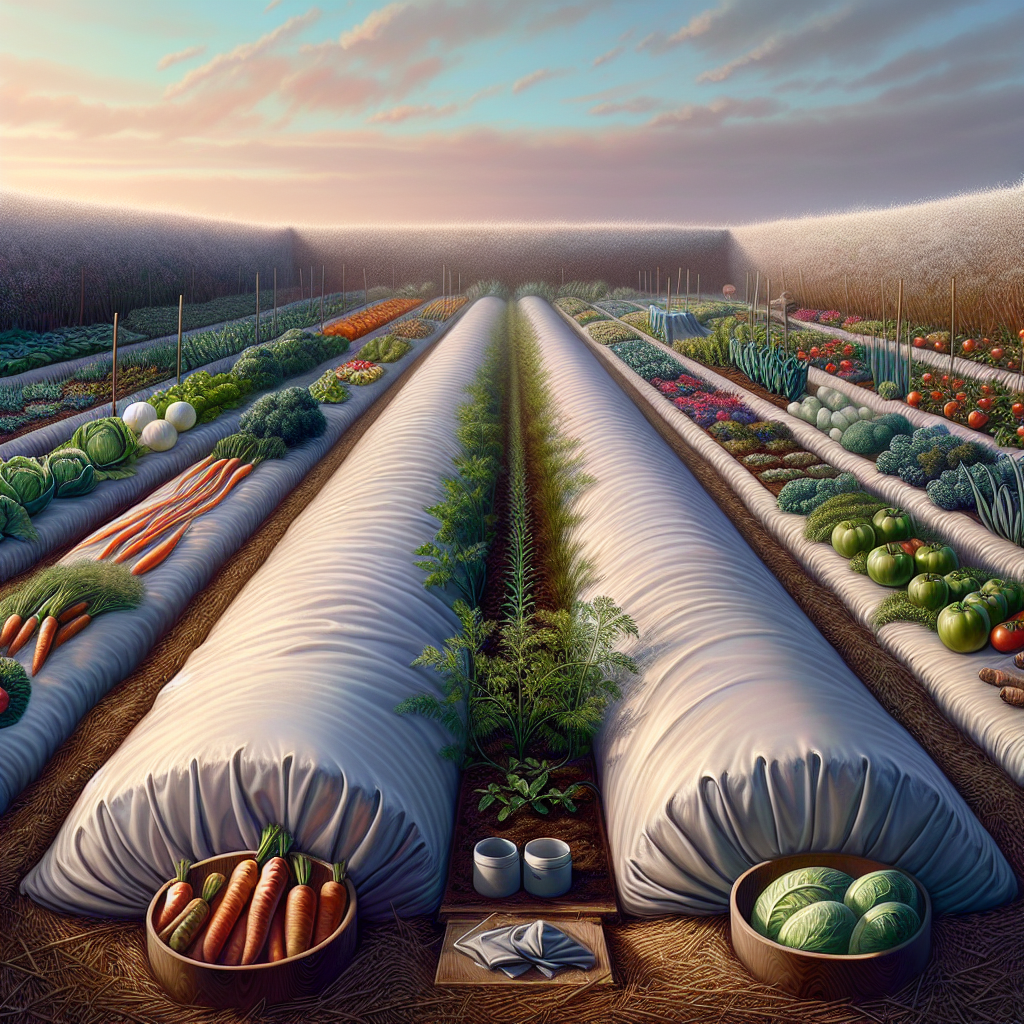How to Protect Vegetable Gardens from Frost Damage
Updated July 6, 2024 at 10:22 am
As temperatures drop, learn how to shield your precious vegetable garden from the harsh embrace of frost with practical strategies and tips, ensuring a thriving harvest no matter the weather.

Understanding Frost and Its Impact on Vegetable Gardens
Frost poses a significant threat to vegetable gardens, particularly during the unpredictable shoulder seasons of spring and fall. It occurs when the temperature drops enough to freeze the moisture on plant leaves and stems, which can result in cellular damage, stunted growth, and even the death of the plants.
To shield your bountiful garden from the clutches of frost, it’s essential to understand the factors that contribute to frost formation, such as clear skies, calm winds, and dropping temperatures during nighttime.
Preventative Measures Against Frost
Prevention is the best form of defense against frost damage in your garden. Gradual acclimation of plants, known as hardening off, strengthens them against the colder nights. You might be considering ways to protect young seedlings, which are exceptionally vulnerable to frost.
One recommended product is the Planket Plant Frost Protection Cover Kit. With great reviews, gardeners have found the Planket to be an effective solution. It’s lightweight, easy to deploy, and can be secured against the wind, offering trusted frost protection for a variety of plant sizes.
Find This and More on Amazon
Physical Barriers for Frost Protection
Physical barriers serve as a first line of defense against frost. Row covers, also known as garden fabric, are particularly effective. They trap heat from the soil, keeping plants snug. People often prefer Agribon AG-19 Floating Row Crop Cover for its durability and effectiveness in protecting against light frosts.
Alongside, cloches – bell-shaped covers – provide individualized protection, making them perfect for sensitive plants. Water-filled teepees also gather and retain heat, creating a warm microclimate around young plants.
Watering Techniques to Ward Off Frost
It may seem counterintuitive, but watering your vegetable garden before a frost can help protect plants. Wet soil retains heat better than dry soil, thus radiating warmth upward during the night. However, it’s a delicate balance as overwatering can contribute to other issues, such as root rot.
When applying this technique, aim to water plants in the morning so that foliage will be dry by evening, reducing the risk of ice forming directly on the plants.
Timing Planting to Avoid Frost
Knowing your region’s last frost date is invaluable for planting your garden without the risk of frost damage. If you’re eager to jump-start the season, consider cool-season vegetables like kale, spinach, or peas, which can tolerate a bit of chill.
For aligning your planting schedule with frost dates, online tools and apps like the “Frost Date Selector by Dave’s Garden” come in handy. Although not reviewed personally, feedback indicates that it’s a reliable source to help you plan your garden timing accurately.
Using Heat Sources to Mitigate Frost Impact
On particularly cold nights, supplemental heat might be necessary. This can range from string lights (make sure they’re outdoor-rated for safety) to designed heat lamps. While these methods are energy-intensive, they can be the difference between a thriving garden and one devastated by frost.
Before employing heaters, always ensure to adhere to safety guidelines to prevent fire hazards in your garden. The products have not been personally assessed, but reviews suggest that buyers are generally satisfied with the effectiveness of outdoor-rated heaters for garden protection.
Understanding Microclimates and Garden Placement
Different areas in your garden can have varying microclimates. Planting your vegetable garden in a location that’s sheltered from prevailing winds and gets ample sunlight can naturally help to minimize frost damage. Additionally, leveraging natural heat sources, such as placing garden beds near a south-facing wall, can provide additional warmth.
If frost does happen, knowing how to harvest properly after a frost can save what could be salvaged from potentially damaged plants.
Selecting Frost-Resistant Varieties
Another strategy might be to focus on cultivating frost-resistant plant varieties. Certain types of vegetables, such as Brussels sprouts and parsnips, are known for their ability to withstand cooler temperatures and even improve in flavor following a light frost.
You might consider consulting with local nurseries or using online resources to discover varieties suited to cooler temperatures. While specific product endorsements aren’t provided here, several seed companies receive positive remarks for their wide range of frost-tolerant seeds.
Monitoring Weather Forecasts and Responding Promptly
Maintaining vigilance through weather apps or local forecasts is crucial to combat unexpected frosts. Quick action, like covering your plants or implementing water techniques, can make all the difference when temperatures drop suddenly.
Engaging with well-reviewed apps like the Farmer’s Almanac Frost Alert can provide timely notifications that might help you take preventive actions promptly.
Ensuring Soil Health to Support Plant Resilience
The health of your garden soil plays a vital role in the resilience of your plants to frost. A well-nourished soil supports stronger plant growth, making them less susceptible to damage. Supplements like compost or mulch not only nourish the soil but also provide insulation against temperature extremes.
Products such as the Miracle-Gro All Purpose Garden Soil receive favorable reviews for providing essential nutrients that can aid plants in withstanding frost by strengthening their root systems.
Find This and More on Amazon
Creating Windbreaks to Shield Plants
Wind exacerbates the chilling effect of frost. By establishing windbreaks using natural barriers like shrubs or using fencing, you can significantly reduce the frost’s impact on your vegetable garden. Not only do they protect against wind, but they can also trap heat around plants, offering a double layer of defense.
This method doesn’t involve specific product highlights, but the effectiveness of organic materials like burlap for making windbreaks is often appreciated among gardeners for their eco-friendliness and efficiency.
Innovative Gardening Solutions Using Technology
In an era where technology has seeped into every aspect of life, don’t overlook innovative gardening gadgets. Soil sensors and smart irrigation systems can optimize garden conditions to fend off frost damage, and these have become quite popular for their convenience and effectiveness.
For example, the use of smart sensors like the Edyn Garden Sensor has been mentioned in various reviews as an excellent aid for monitoring soil conditions, although this is more informative rather than a one-stop solution for frost protection.
Leveraging Community Knowledge and Resources
Finally, the knowledge and experience of fellow gardeners can be an invaluable resource. Local gardening clubs or online forums are wonderful places to exchange tips and advice on frost protection strategies that have worked for others in your area.
Gardeners often find success by applying shared tips such as creating pollinator-friendly spaces that encourage a more robust ecosystem, contributing to healthier plants more capable of withstanding frost.
Utilizing Mulches for Frost Protection
Mulches are not just for weed control and moisture retention; they can also be a formidable ally against frost. Organic mulches such as straw, hay, or even leaves can be spread over the soil surface around plants to help stabilize soil temperatures and reduce the occurrence of ground frost.
When using mulches, apply them evenly and consider their insulating properties as well as their availability. It might be helpful, for instance, to mulch root crops like carrots and beets, which can remain in the ground and be harvested as needed throughout the winter.
Strategic Planting and Garden Layout
The layout of your garden can significantly influence its susceptibility to frost. Taller plants placed strategically can shield more tender plants from frost’s touch, acting as living windbreaks. Raised beds can also ensure good drainage, as frost often damages plants sitting in cold, waterlogged soil.
Proper planning of your garden’s layout can create a microclimate that lessens frost impacts. Engaging with community forums or gardening groups can be a fantastic way to learn about effective garden designs that work well in your region.
Employing Frost Cloths and Horticultural Fleece
Frost cloths, also known as horticultural fleece, are lightweight, breathable fabrics that can be draped over plants to shield them from frost. They allow light and moisture in but keep the damaging frost out. A product like the ‘Gardener’s Supply Company’ All-Purpose Fabric is a garden favorite for its versatility and effectiveness.
The fabric can be easily laid over your plants in the evening and removed in the morning. Users have reported that this fabric is quite durable and can be reused for multiple seasons, making it a cost-effective measure for frost protection.
Choosing the Right Time to Water
As mentioned earlier, watering can be an ally against frost, but the timing of irrigation plays a crucial role. Late afternoon watering allows plants to absorb moisture before temperatures drop, which can help them stay warmer through the night.
Adjusting your watering schedule according to the weather forecast can greatly improve your efforts in frost prevention. Remember to allow soil time to absorb water without causing excessive dampness at night, which might contribute to frost heave and root damage.
Implementing Season Extension Techniques
Season extension techniques like cold frames and hoop houses are not just for getting a head start in the spring; they can also protect plants from early fall frosts. Cold frames, which are essentially miniature greenhouses, can be built or purchased, and are perfect for extending the growing season of leafy greens and herbs.
Hoop houses, which cover larger areas, can be made with PVC pipes and clear plastic sheeting. They offer a practical and relatively inexpensive way to protect larger patches of your garden from frost, and many gardeners speak highly of the simplicity of setting up these structures.
Combining Protection Strategies for Optimal Results
Every garden is unique, and often, a combination of frost protection methods yields the best results. You might find that using row covers in conjunction with mulching and strategic watering can provide comprehensive protection for your plants.
It’s worth experimenting with different combinations to see what works best for your specific garden circumstances. There’s a wealth of knowledge within the gardening community about combining techniques effectively, and tapping into this can unlock the full potential of your vegetable garden, even in colder weather.
Assessing and Repairing Frost Damage
In the unfortunate event that frost does damage your plants, assessing the extent of the damage is crucial. Light frost might just nip the tips of the plants, which can recover with proper care — such as pruning the damaged parts to prevent disease and encourage new growth.
If plants are heavily affected, it’s important to assess whether they can be saved. Sometimes, allowing the sun to gradually thaw the frost before you take action can minimize further damage to the plant tissues.
Learning from Experience for Future Seasons
Every frost event can teach us valuable lessons on protecting our vegetable gardens. By documenting what worked and what didn’t, you can refine your frost protection strategies for future growing seasons.
Engaging in reflective gardening practices helps to build a personal knowledge base that’s tailored to your garden’s specific needs, making you more prepared to face the challenges that frost may present next time.
Developing a Frost Alert System
Setting up your own frost alert system can be a proactive way to defend your garden against unexpected freezing temperatures. You can use simple thermometers to monitor the air temperature or invest in more sophisticated wireless temperature sensors that send alerts to your phone.
Popular devices like the AcuRite Wireless Digital Thermometer have been highly rated for their accuracy and convenience, allowing gardeners to respond quickly to plunging temperatures that could signal impending frost.
Understanding the Weather Patterns and Microclimates in Your Area
Being intimately familiar with your local weather patterns and the specific microclimates of your garden can significantly aid in protecting against frost. Observing patterns over time gives you an edge in knowing when and where frost is likely to strike first.
Engaging with regional weather services or taking advantage of educational resources at local extension offices can further enhance your understanding, helping you to create a tailored approach to frost protection in your vegetable garden.
Making Use of Frost Blankets and Plant Covers
Frost blankets and plant covers can be a gardener’s best friend when temperatures drop. These specially designed blankets provide insulation and warmth to plants, especially when used in conjunction with supporting frames that prevent the material from directly touching the foliage.
The DeWitt N-Sulate Frost Blanket is a popular choice, noted for its heavyweight fabric that gardeners find to be effective at protecting even the most frost-sensitive plants. It has been remarked as an invaluable tool for extending the growing season.
Find This and More on Amazon
Creating a Journal for Garden Observations
Recording your observations in a garden journal can be an excellent way to track your garden’s response to different frost protection techniques. It serves as a personal reference over the years and can guide you in optimizing your strategies for frost prevention.
Documenting temperature changes, frost occurrences, and the resulting plant health can reveal patterns and aid in predicting how your garden may behave under similar conditions in the future. Plus, it’s a rewarding way to see your growth as a gardener!
Implementing Diverse Planting for a Resilient Garden
Diversity in planting can enhance your garden’s resilience to frost. Interspersing frost-sensitive plants with hardier varieties can reduce the risk of total crop loss when frost strikes. The idea is that if some plants are damaged by the frost, others will survive and continue to provide a yield.
A biodiverse garden also promotes a healthier ecosystem, which, in turn, strengthens all plants within it, making them more capable of surviving adverse conditions like an unexpected frost.
Remembering the Basics: Cover, Insulate, and Shield
When frost threatens, revert to the basics of garden care: cover, insulate, and shield. Utilizing garden fabrics, mulches, and barriers can be quick and effective methods to protect your vegetables from the bitterness of an early frost.
Remember, even simple solutions such as overturned buckets or pots can provide temporary protection for small and individual plants, a tactic that has been shared and proven effective in many winter vegetable gardening community circles.
Frost Tolerance vs. Frost Resistance in Plants
Understanding the difference between frost tolerance and frost resistance in plants is essential. Frost-tolerant plants can survive some degree of frost with little to no damage, while frost-resistant varieties can endure even lower temperatures without harm.
Focusing on frost-resistant or frost-tolerant plants, especially for early and late-season planting, can save you a lot of trouble and worry when cooler temperatures are in the forecast.
Building a Support Network with Local Gardeners
Building relationships with local gardeners can provide a support network from which to draw knowledge and experience. Whether it’s through community gardens, gardening clubs, or online forums, engaging with others who share the challenge of protecting their plants from frost will offer new insights and collective wisdom.
Such a network can be invaluable, especially when you encounter a situation that’s new to you, but perhaps someone else has already successfully navigated.
Incorporating Permaculture Principles for Frost Management
Permaculture principles focus on creating sustainable and self-sufficient gardens which can naturally include techniques to mitigate frost damage. Observing patterns, using multifunctional plants, and creating microclimates are all permaculture strategies that can enhance frost protection.
For instance, the use of ground covers in permaculture not only conserves moisture and suppresses weeds but also aids in insulating the soil against temperature fluctuations that lead to frost.
Knowing When to Seek Professional Advice
Finally, despite all your best efforts, sometimes frost can cause serious damage to your garden. Knowing when to seek professional advice for rehabilitation strategies can save your garden from longer-term setbacks.
Expert horticulturists or local cooperative extension services can provide tailored advice and recovery plans specifically for your garden’s needs, helping you to restore and even improve your vegetable garden after frost damage.
Shop more on Amazon
Flowers & Plants Team
Flowers & Plants Team


